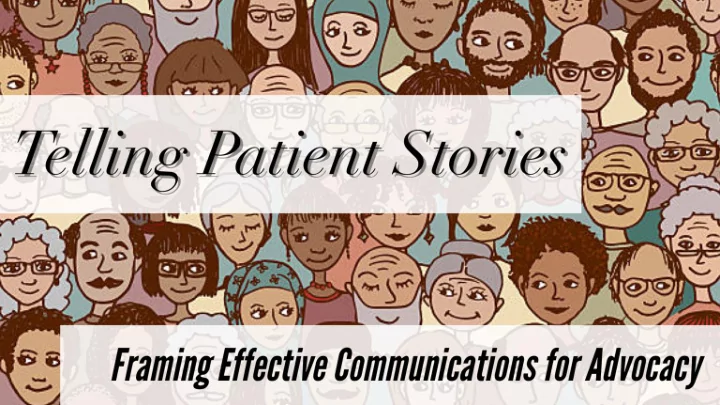

The Power and Paradox of Patient Stories
Patient stories can: Provide a human face to your Draw unwanted judgements ● ● narrative Increase stigma ● Attract the interest of journalists and ● the public Create an unrealistic ● understanding of the problem Make people relate to the issues you ● care about Alienate your audience ● Bolster fundraising Overwhelm your audience ● ● Reduce stigma Reinforce negative false ● ● opinions Demonstrate your impact on ● people’s lives
Framing Matters Focus on the structural barriers facing Focus on your client / patient your client How has this issue impacted other What are the barriers that individuals can aspects of their life? influence or control? Who is the villain in creating these barriers? Finances ● Social relationships ● Lack of funding for community health ● Economic opportunity ● centers Discriminatory practices committed by ● landlords, potential employers, etc Stigma perpetuated by community ● members or peers
Dangers in Crafting Stories About Marginalized Groups Boomerang Effect : An attempt to convince someone to adopt an opinion results in them adopting the opposite position. Confirmation Bias : The tendency to interpret new evidence as confirmation of one's existing beliefs or theories.
Kaiser Health News “What The Health” series
Telling Stories to Affect Change Problems may seem overwhelming, but don’t overwhelm your audience. Always have a call to action and an opportunity for the reader to act. Meet your audience where they are. Remember to talk about your organization’s impact.
Selecting Stories Your patient may be the “face” of this story, but they must be relatable. Vet these stories and patients first. Prepare your patient for the next steps: Ask if they are comfortable sharing their story to bring attention to ● the issue. Let them know that they can speak on or off the record, and can ● use only their first name, a pseudonym, or be anonymous. Be clear about what health information can or cannot be shared. ● Make the initial contact through your organization, do not give a ● patient’s information directly to a journalist.
Telling Your Stories Through Media Media can help: Fundraising Speaking to your members Motivating grassroots activity Informing your followers of the issues Connecting you with those who can help Creating real change
Social media Earned media Organization media Gives credibility to your Create your own content, Ability to write your own story. issue or cause. for free. Distribution can be challenging. Higher chances of getting Reliance on others to your story in front of the Trust in your organization is key to a amplify your message. right people. reader. Need to break through Takes time to develop a Content creation is time the noise. story with a journalist. consuming. Coverage relies on a tie to something newsworthy or a new development.
Social media Think visual! A picture tells a thousand words. Twitter, Facebook, Instagram, Snapchat, LinkedIn all attract different demographics. Know your audience! Social media is a conversation - speak with your followers the way you would a friend. Images and videos showing positive human connection boost engagement.
Social Media Can Inform You! Twitter accounts: Hashtags: Sec. Alex Azar: @SecAzar #EndHIVEpidemic HRSA: @HRSAgov #EtE Adm. Brett Giroir: @HHS_ASH #EndHIV Dr. Robert Redfield: @CDCDirector HIV.gov: @HIVgov Organizations: NIH: @NIAIDnews CDC HIV/AIDS: @CDC_HIVAIDS NASTAD: @NASTAD NIH AIDS Info: @AIDSinfo AIDS United: @AIDS_United NMAC: @NMACCommunity TargetHIV: @ryanwhitecare
Earned media National news, local broadcast news outlets, national syndication news outlets, niche trade press, radio, podcasts, and more. Research the right outlet and the right journalist to tell your story. Patient’s perspective / experience is key! Tell the patient’s whole story, with an eye on cracks in the system. Be prepared to follow up!
Organization Generated Media Press Releases, Blogs, Fundraising Materials , Advertisements, Op Eds / Guest Blog Posts Have a clear message on the problem, and use your stories as an example. There may be numerous issues, but focus in on one main point. You control your own distribution. Headlines matter!
Thank you!
Recommend
More recommend